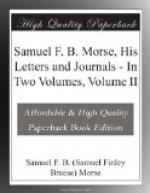[Illustration: SARAH ELIZABETH GRISWOLD Second wife of S.F.B. Morse]
But now the first of the great lawsuits, which were to confirm Morse’s patent rights or to throw his invention open to the world, was begun, and, with his young bride, he hastened to Frankfort to be present at the trial. To follow these suits through all their legal intricacies would make dry reading and consume reams of paper. Mr. Prime in a footnote remarks: “Mr. Henry O’Reilly has deposited in the Library of the New York Historical Society more than one hundred volumes containing a complete history of telegraphic litigation in the United States. These records are at all times accessible to any persons who wish to investigate the claims and rights of individuals or companies. The testimony alone in the various suits fills several volumes, each as large as this.”
It will, therefore, only be necessary to say that almost all of these suits, including the final one before the Supreme Court of the United States, were decided in Morse’s favor. Every legal device was used against him; his claims and those of others were sifted to the uttermost, and then as now expert opinion was found to uphold both sides of the case. To quote Mr. Prime:
“The decision of the Supreme Court was unanimous on all the points involving the right of Professor Morse to the claim of being the original inventor of the Electro-Magnetic Recording Telegraph. A minority of the court went still further, and gave him the right to the motive power of magnetism as a means of operating machinery to imprint signals or to produce sounds for telegraphic purposes. The testimony of experts in science and art is not introduced because it was thoroughly weighed and sifted by intelligent and impartial men, whose judgment must be accepted as final and sufficient. The justice of the decision has never been impugned. Each succeeding year has confirmed it with accumulating evidence.
“One point was decided against the Morse patent, and it is worthy of being noticed that this decision, which denied to Morse the exclusive use of electromagnetism for recording telegraphs, has never been of injury to his instrument, because no other inventor has devised an instrument to supersede his.
“The court decided that the Electro-Magnetic Telegraph was the sole and exclusive invention of Samuel F.B. Morse. If others could make better instruments for the same purpose, they were at liberty to use electromagnetism. Twenty years have elapsed since this decision was rendered; the Morse patent has expired by limitation of time, but it is still without a rival in any part of the world.”
This was written in 1873, but I think that I am safe in saying that the same is true now after the lapse of forty more years. While, of course, there have been both elaboration and simplification, the basic principle of the universal telegraph of to-day is embodied in the drawings of the sketch-book of 1832, and it was the invention of Morse, and was entirely different from any form of telegraph devised by others.




